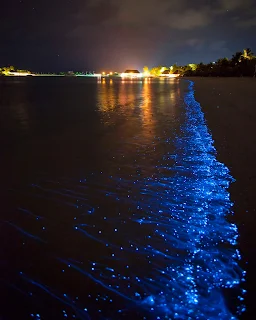The Sea of Stars makes Vaadhoo island very famous among tourist. This marine bio-luminescence is generated by phytoplankton known as dinoflagellates. Woodland Hastings of Harvard University has for the first time identified a special channel in the dinoflagellate cell membrane that responds to electrical signals offering a potential mechanism for how the algae create their unique illumination.
The Sea of Stars at Vadhoo Island occurrence is caused by bio-luminescence, and is the effect of chemical reactions in phytoplankton, microorganisms that lives in water, that occurs when the oxygen levels changes in the water. These microorganism are a source of food to many sea creatures, and this is their defense mechanism.
The microorganisms have a very powerful glow that can be seen across
the membranes of their predators. This puts the predators at a risk of
attracting larger predators. So for the sake of many, a few would
sacrifice themselves to light up who ever consumes them, therefore, the
predators would rather avoid feeding on the bio-luminescent
phytoplankton.
A common type of these bioluminescent phytoplankton goes by the name of dinoflagellate. They are unicellular protists that are photosyntyhetic. Some of the bioluminescent phytoplankton’s blue light may be toxic. Some dinoflagellates for example, are very toxic even to human beings. They may produce a neurotoxin that is quite dangerous to animals and may cause paralysis.
Mechanical stress may cause the phenomenon, as in the case of red tides. Movement around the dinoflagellates causes electrical impulses to be sent to a proton-filled compartment in their body. The pulses open proton ion channels that lead to the part of the cell that produces the light called the Scintillon. Proteins then flow in and after a series of reactions, cause the cell to glow. Oxygen plays an important role as a catalyst, and hence any changes in oxygen levels in the water will lead to bio-luminescence.
Dinoflagellates are not the only bioluminescent creatures in the world. Other sea creatures that exhibit the same characteristics include anglerfish, deep-sea squid, krill and certain types of jellyfish. Fireflies fall in this category as well.
Despite Vadhoo Island not being the only place in the world where bioluminescent phytoplankton are found, it is most definitely the best. They are also found in Rangali and Mudhdhoo within the same country. Other places in the world you can find the same phenomena is Lakshadweep Islands in India and Mosquito Bay in Puerto Rico. During red tides in Leucadia Coast, Carlifornia, this luminescence can be seen too. The best time to see it is when there is no moon at night. If you come across them, you can wave your hand on the sand where the phytoplankton is to produce shapes of your liking.
Dinoflagellates are not the only bioluminescent creatures in the world. Other sea creatures that exhibit the same characteristics include anglerfish, deep-sea squid, krill and certain types of jellyfish. Fireflies fall in this category as well.
Despite Vadhoo Island not being the only place in the world where bioluminescent phytoplankton are found, it is most definitely the best. They are also found in Rangali and Mudhdhoo within the same country. Other places in the world you can find the same phenomena is Lakshadweep Islands in India and Mosquito Bay in Puerto Rico. During red tides in Leucadia Coast, Carlifornia, this luminescence can be seen too. The best time to see it is when there is no moon at night. If you come across them, you can wave your hand on the sand where the phytoplankton is to produce shapes of your liking.






















No comments:
Post a Comment
Stay updated with our blog for more quality content! Your feedback is appreciated. Contact us at harshrex@outlook.com with any suggestions.